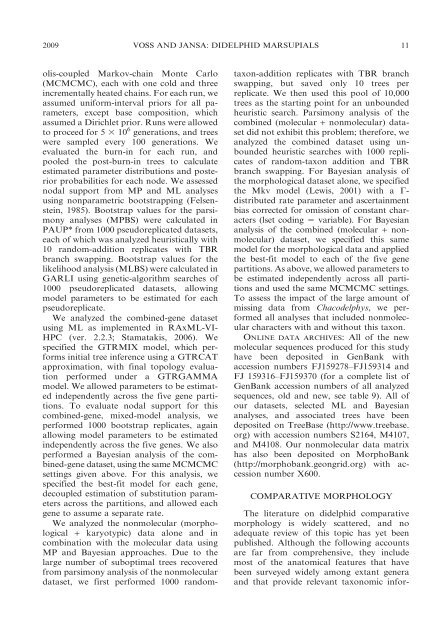phylogenetic relationships and classification of didelphid marsupials ...
phylogenetic relationships and classification of didelphid marsupials ...
phylogenetic relationships and classification of didelphid marsupials ...
Create successful ePaper yourself
Turn your PDF publications into a flip-book with our unique Google optimized e-Paper software.
2009 VOSS AND JANSA: DIDELPHID MARSUPIALS 11<br />
olis-coupled Markov-chain Monte Carlo<br />
(MCMCMC), each with one cold <strong>and</strong> three<br />
incrementally heated chains. For each run, we<br />
assumed uniform-interval priors for all parameters,<br />
except base composition, which<br />
assumed a Dirichlet prior. Runs were allowed<br />
to proceed for 5 3 10 6 generations, <strong>and</strong> trees<br />
were sampled every 100 generations. We<br />
evaluated the burn-in for each run, <strong>and</strong><br />
pooled the post-burn-in trees to calculate<br />
estimated parameter distributions <strong>and</strong> posterior<br />
probabilities for each node. We assessed<br />
nodal support from MP <strong>and</strong> ML analyses<br />
using nonparametric bootstrapping (Felsenstein,<br />
1985). Bootstrap values for the parsimony<br />
analyses (MPBS) were calculated in<br />
PAUP* from 1000 pseudoreplicated datasets,<br />
each <strong>of</strong> which was analyzed heuristically with<br />
10 r<strong>and</strong>om-addition replicates with TBR<br />
branch swapping. Bootstrap values for the<br />
likelihood analysis (MLBS) were calculated in<br />
GARLI using genetic-algorithm searches <strong>of</strong><br />
1000 pseudoreplicated datasets, allowing<br />
model parameters to be estimated for each<br />
pseudoreplicate.<br />
We analyzed the combined-gene dataset<br />
using ML as implemented in RAxML-VI-<br />
HPC (ver. 2.2.3; Stamatakis, 2006). We<br />
specified the GTRMIX model, which performs<br />
initial tree inference using a GTRCAT<br />
approximation, with final topology evaluation<br />
performed under a GTRGAMMA<br />
model. We allowed parameters to be estimated<br />
independently across the five gene partitions.<br />
To evaluate nodal support for this<br />
combined-gene, mixed-model analysis, we<br />
performed 1000 bootstrap replicates, again<br />
allowing model parameters to be estimated<br />
independently across the five genes. We also<br />
performed a Bayesian analysis <strong>of</strong> the combined-gene<br />
dataset, using the same MCMCMC<br />
settings given above. For this analysis, we<br />
specified the best-fit model for each gene,<br />
decoupled estimation <strong>of</strong> substitution parameters<br />
across the partitions, <strong>and</strong> allowed each<br />
gene to assume a separate rate.<br />
We analyzed the nonmolecular (morphological<br />
+ karyotypic) data alone <strong>and</strong> in<br />
combination with the molecular data using<br />
MP <strong>and</strong> Bayesian approaches. Due to the<br />
large number <strong>of</strong> suboptimal trees recovered<br />
from parsimony analysis <strong>of</strong> the nonmolecular<br />
dataset, we first performed 1000 r<strong>and</strong>om-<br />
taxon-addition replicates with TBR branch<br />
swapping, but saved only 10 trees per<br />
replicate. We then used this pool <strong>of</strong> 10,000<br />
trees as the starting point for an unbounded<br />
heuristic search. Parsimony analysis <strong>of</strong> the<br />
combined (molecular + nonmolecular) dataset<br />
did not exhibit this problem; therefore, we<br />
analyzed the combined dataset using unbounded<br />
heuristic searches with 1000 replicates<br />
<strong>of</strong> r<strong>and</strong>om-taxon addition <strong>and</strong> TBR<br />
branch swapping. For Bayesian analysis <strong>of</strong><br />
the morphological dataset alone, we specified<br />
the Mkv model (Lewis, 2001) with a Cdistributed<br />
rate parameter <strong>and</strong> ascertainment<br />
bias corrected for omission <strong>of</strong> constant characters<br />
(lset coding 5 variable). For Bayesian<br />
analysis <strong>of</strong> the combined (molecular + nonmolecular)<br />
dataset, we specified this same<br />
model for the morphological data <strong>and</strong> applied<br />
the best-fit model to each <strong>of</strong> the five gene<br />
partitions. As above, we allowed parameters to<br />
be estimated independently across all partitions<br />
<strong>and</strong> used the same MCMCMC settings.<br />
Toassesstheimpact<strong>of</strong>thelargeamount<strong>of</strong><br />
missing data from Chacodelphys, we performed<br />
all analyses that included nonmolecular<br />
characters with <strong>and</strong> without this taxon.<br />
ONLINE DATA ARCHIVES: All <strong>of</strong> the new<br />
molecular sequences produced for this study<br />
have been deposited in GenBank with<br />
accession numbers FJ159278–FJ159314 <strong>and</strong><br />
FJ 159316–FJ159370 (for a complete list <strong>of</strong><br />
GenBank accession numbers <strong>of</strong> all analyzed<br />
sequences, old <strong>and</strong> new, see table 9). All <strong>of</strong><br />
our datasets, selected ML <strong>and</strong> Bayesian<br />
analyses, <strong>and</strong> associated trees have been<br />
deposited on TreeBase (http://www.treebase.<br />
org) with accession numbers S2164, M4107,<br />
<strong>and</strong> M4108. Our nonmolecular data matrix<br />
has also been deposited on MorphoBank<br />
(http://morphobank.geongrid.org) with accession<br />
number X600.<br />
COMPARATIVE MORPHOLOGY<br />
The literature on <strong>didelphid</strong> comparative<br />
morphology is widely scattered, <strong>and</strong> no<br />
adequate review <strong>of</strong> this topic has yet been<br />
published. Although the following accounts<br />
are far from comprehensive, they include<br />
most <strong>of</strong> the anatomical features that have<br />
been surveyed widely among extant genera<br />
<strong>and</strong> that provide relevant taxonomic infor-

















